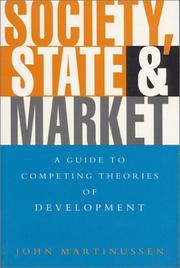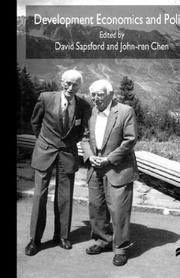| Listing 1 - 10 of 7610 | << page >> |
Sort by
|
Multi
ISBN: 9789264229082 9264229086 Year: 1987 Publisher: Paris: OCDE,
Abstract | Keywords | Export | Availability | Bookmark
 Loading...
Loading...Choose an application
- Reference Manager
- EndNote
- RefWorks (Direct export to RefWorks)
L’Évaluation des activités de coopération au développement est l'un des domaines où l'influence du CAD sur la politique et la pratique peut le plus facilement être observée. Avoir un système d'évaluation qui est bien établi est l'une des conditions requise pour être membre du CAD. Chaque examen par les pairs examine la mise en place et la gestion de la fonction d'évaluation, en utilisant les normes et standards élaborés par le Réseau du CAD sur l'évaluation du développement.

ISBN: 185649442X Year: 1997 Publisher: London Zed Books
Abstract | Keywords | Export | Availability | Bookmark
 Loading...
Loading...Choose an application
- Reference Manager
- EndNote
- RefWorks (Direct export to RefWorks)
Book
ISBN: 9264801456 9264459715 Year: 2019 Publisher: Paris, France : OECD Publishing,
Abstract | Keywords | Export | Availability | Bookmark
 Loading...
Loading...Choose an application
- Reference Manager
- EndNote
- RefWorks (Direct export to RefWorks)
Periodical
ISSN: 26850788 18295843 Year: 2003 Publisher: Indralaya : Jurusan Ekonomi Pembangunan, Fakultas Ekonomi Universitas Sriwijaya,
Abstract | Keywords | Export | Availability | Bookmark
 Loading...
Loading...Choose an application
- Reference Manager
- EndNote
- RefWorks (Direct export to RefWorks)
Book
ISBN: 1003311156 1003311156 1000630838 1000630846 1032114665 Year: 2022 Publisher: Abingdon, Oxon, England ; New York, New York : Routledge,
Abstract | Keywords | Export | Availability | Bookmark
 Loading...
Loading...Choose an application
- Reference Manager
- EndNote
- RefWorks (Direct export to RefWorks)

ISBN: 0312210418 Year: 1998 Publisher: New York (N.Y.) : St. Martin's press,
Abstract | Keywords | Export | Availability | Bookmark
 Loading...
Loading...Choose an application
- Reference Manager
- EndNote
- RefWorks (Direct export to RefWorks)
Book
Year: 1983 Publisher: Bern : Peter Lang International Academic Publishing Group,
Abstract | Keywords | Export | Availability | Bookmark
 Loading...
Loading...Choose an application
- Reference Manager
- EndNote
- RefWorks (Direct export to RefWorks)
Im allgemeinen wird davon ausgegangen, dass die Exporterlösinstabili- tät von Entwicklungsländern ihre wirtschaftliche Entwicklung beein- trächtige und dass deshalb ihre Exporterlöse zu stabilisieren seien. In der Arbeit wird kritisch analysiert, inwieweit Grundlagen für eine rationale Politik der Exporterlösstabilisierung vorhanden sind. Im ersten Teil wird untersucht, inwieweit die mit einer Exporterlösstabilisierung angestrebten Ziele dem Rationalitätserfordernis entsprechen. Im zweiten Teil werden Hypothesen und empirische Studien über Auswirkungen von Exporterlösinstabilität im Hinblick auf ihren Informationsgehalt für eine rationale Politik der Exporterlösstabilisierung analysiert.
Book
Year: 2022 Publisher: [Place of publication not identified] : Verlag der Österreichischen Akademie der Wissenschaften,
Abstract | Keywords | Export | Availability | Bookmark
 Loading...
Loading...Choose an application
- Reference Manager
- EndNote
- RefWorks (Direct export to RefWorks)
Due to its diverse natural conditions, the Himalayas are particularly suitable for research on craft traditions. The book clearly shows connections between natural and cultural parameters and regional building and craft traditions and their influence on the material culture in the Himalayas. Der Himalaya bietet sich für die Forschung zu Handwerkstraditionen durch dessen vielfältige naturräumliche Gegebenheiten an. Das Buch zeigt anschaulich Zusammenhänge zwischen natur- und kulturräumlichen Parametern und regionalen Bau- und Handwerkstraditionen und deren Einfluss auf die materielle Kultur im Himalaya.
Book
Year: 2014 Publisher: Paris : Agence Française de Développement,
Abstract | Keywords | Export | Availability | Bookmark
 Loading...
Loading...Choose an application
- Reference Manager
- EndNote
- RefWorks (Direct export to RefWorks)
Book
Year: 2005 Publisher: [Washington, D.C. : World Bank,
Abstract | Keywords | Export | Availability | Bookmark
 Loading...
Loading...Choose an application
- Reference Manager
- EndNote
- RefWorks (Direct export to RefWorks)
"The authors focus on the evaluation of the antidumping regime from 1988 through 2003. During these years the Brazilian economy had to cope with several periods of macroeconomic instability and overvaluation of the domestic currency, particularly from 1990-92 and 1994-98. As a result, from 1992 through 1998, import volumes increased significantly. Although during these years, the demand for antidumping protection was growing, the number of investigations concluded with an affirmative determination was only 52 percent. The authors explain that the institutional framework in charge of administering the antidumping regime was subject to several reforms. Along this process, the Ministry of Development, Industry, and Trade saw its role strengthened. This ministry has a more protectionist bias than the Ministry of Finance that, during the initial years of the liberalization program, played a prominent role in decisions regarding antidumping investigations and measures. The authors conclude that in comparison with other countries that are important users of the antidumping mechanism, the Brazilian experience reveals two interesting features: 1) A relatively small rate of final positive determinations. 2) A tradition of applying antidumping duties in amounts that on average have been quite lower than the full dumping margins. "--World Bank web site.
| Listing 1 - 10 of 7610 | << page >> |
Sort by
|

 Search
Search Feedback
Feedback About UniCat
About UniCat  Help
Help News
News